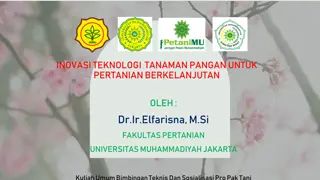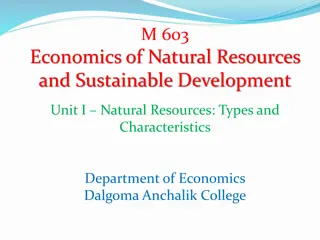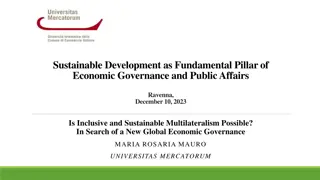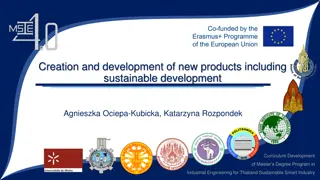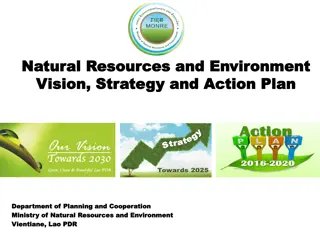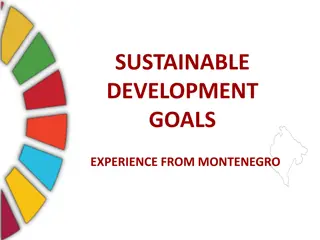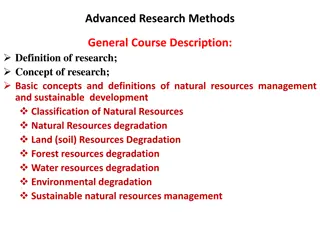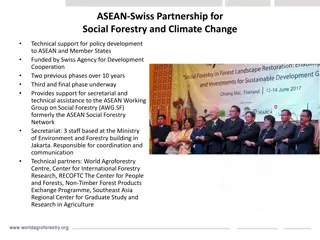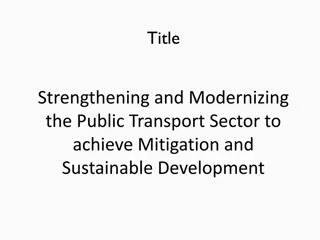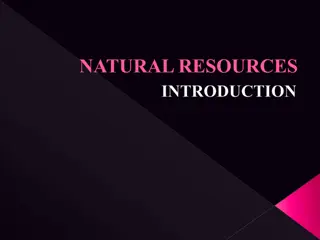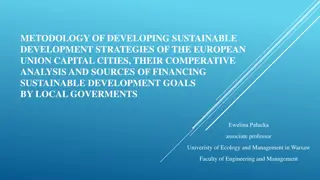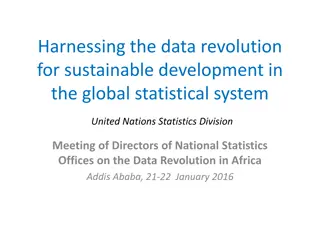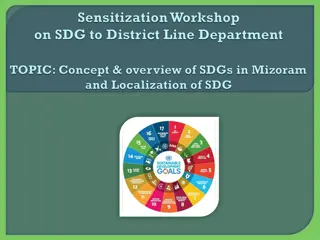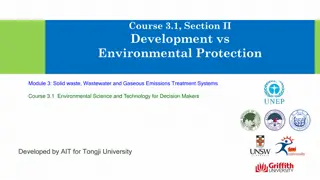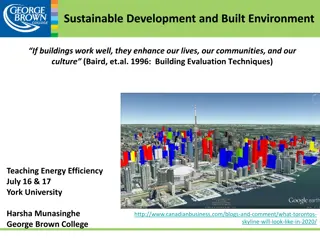Understanding Natural Resources and Sustainable Development
Explore the classification and utilization of resources, factors influencing them, methods of conservation, and strategies for sustainable development outlined in this comprehensive guide. Learn how to identify, protect, and manage natural resources effectively for a more sustainable future.
- Natural Resources
- Sustainable Development
- Conservation Methods
- Environmental Studies
- Resource Management
Download Presentation

Please find below an Image/Link to download the presentation.
The content on the website is provided AS IS for your information and personal use only. It may not be sold, licensed, or shared on other websites without obtaining consent from the author. Download presentation by click this link. If you encounter any issues during the download, it is possible that the publisher has removed the file from their server.
E N D
Presentation Transcript
Environmental Studies Unit 2 Natural Resources and Sustainable Development
Resources A resource can be defined as means of attaining given ends . In simple word it can be defined as a natural stuff or manmade product which satisfies human needs or wants directly or indirectly. An Endowment is any natural stuff that exists in environment, the use of which is not known to man at present. The Potential resources are that natural stuff that exists in the environment , whose use and value is known to man but the stuff is not in use at present to satisfy human needs or wants. So the resource is not a static but a dynamic concept.
Classification of Resources A) Frequency of occurrence Ubiquitous Air, Sunlight Localized Coal, oil B) Ownership of resources Individual resources - land, house National resources rivers, forests International resources - sunlight, Oceans C) Nature of resource Organic or biotic resources forests, fish, crops Inorganic or abiotic resources - minerals, rocks
D) On the basis of durability, availability and regeneration 1. Natural / Physical Resources Inexhaustible / Renewable/flow resources air, water Automatically renewable Renewable with efforts of man Exhaustible/ Non renewable resources Recyclable Non recyclable 2. Human/ Cultural
Factors influencing resources 1. Cost benefit ratio 2. Cheaper substitutes 3. Availability of Capital 4. Market and it s size 5. Availability of skilled labors 6. Customs and traditions of people 7. Political factors 8. Resource policy
Methods of Conservation Substitution Recycling Innovation Minimization of waste Enforcement of Laws Correct Estimation Policy of conservation
Resource Utilisation and Sustainability 1. Find substitute to certain resources which are limited. E.g. Coal, Oil. 2. Waste generated should be easily degradable or its recycling. 3. Overexploitation of resources must be avoided. 4. Some strategies for conservation of resources should be formed. 5. Some strategies should be formed while exploiting natural resources.
Rio Declaration 1992 1. 2. 3. 4. All people shall have healthy and productive life in harmony with nature. Nations to take precaution to protect environment. Nations shall constitute an integral part of the development process. All nations shall cooperate to conserve resources, protect and restore the health and ecosystems. All nations shall reduce and eliminate unsustainable patterns of production and consumption. Nations shall encourage public awareness and participation. All nations shall enact all environmental laws and develop their own national laws Nations shall co-operate to promote an open international economic system. All nations shall inform each other about natural disasters or activities which may have harmful impacts on other neighboring nations. 10. All nations shall share knowledge and innovative technologies to achieve the goal of sustainability. 5. 6. 7. 8. 9.
Conventional and Non conventional Energy Resources Coal Oil Natural Gas Water power Nuclear energy Non conventional- Renewable energy resources. Solar energy Wind energy Tidal energy Biogas energy Geothermal energy Alcohol from biomass Conventional - Resources which are neither reusable nor recyclable.
Energy resource Growing energy demand for growing population, industries, transport sector, growing urban population, for growing consumerism, wastage of energy resources. Mitigation and measures for energy conservation Creation of awareness Improving efficiency of equipments, machinery, appliances etc. Energy or fuel conservation Compulsory energy audits Development of non conventional energy resources Improve power sector in India Increasing use of railways and public transport. Improvement in vehicle design, road conditions. Reforms in energy policy. The imposition of a carbon tax.
Measures to solve energy crisis Awareness Improve the efficiency of equipments and upgrade equipments. Use of non conventional energy resources Maintaining energy audits Conservation of sound ecosystem Improve power sector in India Modernization of power plants Cut on subsidies in power sector. Increasing share of railways and public transport Promoting efficient practices for conservation in household sector.
Water Resource Distribution of water
Sources of water Oceans Snow, Glaciers Groundwater Rivers and streams Lakes and ponds Wetlands The atmosphere
Water Pollution Sewage Industrial Effluents Eutrophication Sedimentation and Silting Radioactive waste Thermal pollution
Water Management Construction of small dams Conservation in agricultural sector Conservation in urban areas Water shed management Rain water harvesting Reclaiming wetlands Forest belt Controlling water pollution
Forest Resources Importance Ecological Balance Food Fuel Forest products Medicines Raw material
A. Tropical hardwood forest (0 to 30 degree N & S of equator) 1. Wet equatorial forest: Hot and wet climate. Congo basin of Africa, Amazon basin of South America, Indonesia, Malaysia, Philippines. These forests contribute for 5.20% forest area of the world. Dense forest with tall trees. E.g. Ebony, Mahogany, Rosewood, Ironwood, Brazil nut, Rubber. 2. Monsoon forest: Semi evergreen trees. India, Myanmar, Thailand etc. This forest contribute for 9% forest area of the world. These forests are broad leafed and shed leaves during dry season so called as deciduous forest. E.g Teak, Sal, Sandalwood, Mango, Neem. B. Temperate hardwood forests. (30 to 50 degree N & S latitudes) Temperature and rainfall is moderate. N.W. Europe, N.E. United States of America, S. W. Siberia. Japan, Korea, China. These forests contribute for 13% of forest area of the world. E.g. Oak, Birch, Maple, Walnut, Chestnut
C . Temperate softwood coniferous or Taiga forests. (30 to 50 degree N & S latitudes) This forest covers a broad belt of land in N. America and Eurasia. Climate is cold, with precipitation in the form of snow. Trees have conical shape with needle shape leaves. These forests contribute for 25 % forest area of the world. E.g. Pine, Spruce, Birch, Haddock. Countries are Canada, U.S.A, Norway, Sweden, Finland and Eastern Russia.
Causes of deforestation Agriculture and grazing Beef for World Market Commercial logging Logging concessions Raising of crops
Effects of deforestation Atmospheric pollution Disturbances in hydrological cycle Deforestation Loss of biodiversity Increased rate of soil erosion Increased risk of landslides Economic losses
Forest Management/ Measures to solve forest problems Afforestation Improved cutting practices Control forest fire Control on pest and diseases on forest Reduce wastage of forest products Use of substitute products Increase the area under forest cover Stop indiscriminate lumbering Increase logging taxes



